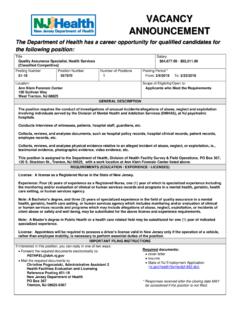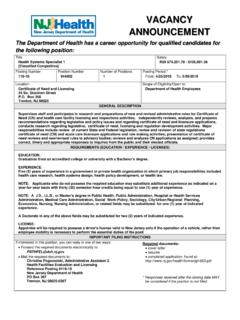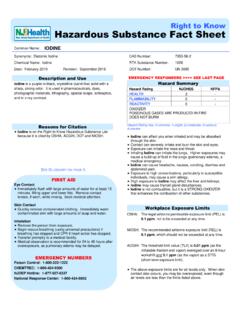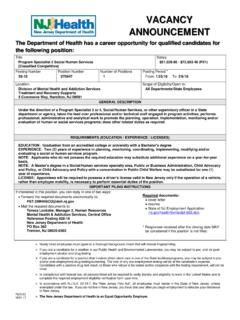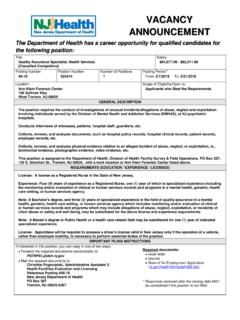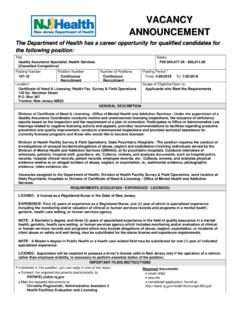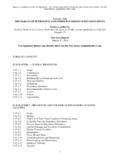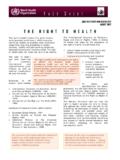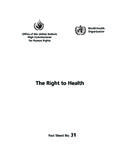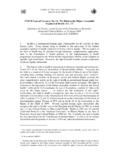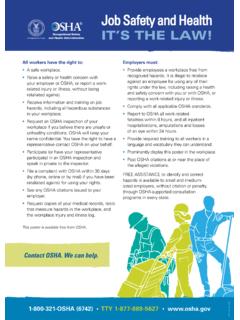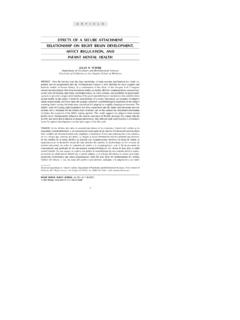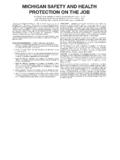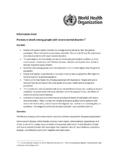Transcription of Right to Know Hazardous Substance Fact Sheet
1 Right to Know Hazardous Substance fact Sheet Common Name: METHYLENE CHLORIDE Synonyms: Dichloromethane; Methylene Dichloride Chemical Name: Methane, Dichloro- Date: October 2008 Revision: September 2016 CAS Number: 75-09-2 RTK Substance Number: 1255 DOT Number: UN 1593 Description and Use Methylene Chloride is a colorless, volatile, liquid with a sweet odor. It is used as a paint and varnish remover, solvent for plastics, degreasing agent, propellant, and blowing agent. ODOR THRESHOLD=25 to 150 ppm Odor thresholds vary greatly. Do not rely on odor alone to determine potentially Hazardous exposures. Reasons for Citation Methylene Chloride is on the Right to Know Hazardous Substance List because it is cited by OSHA, ACGIH, DOT, NIOSH, NTP, DEP, IARC, NFPA and EPA. This chemical is on the Special health Hazard Substance List. SEE GLOSSARY ON PAGE 5. FIRST AID Eye Contact Immediately flush with large amounts of water for at least 30 minutes, lifting upper and lower lids.
2 Remove contact lenses, if worn, while flushing. Seek medical attention. Skin Contact Quickly remove contaminated clothing. Immediately wash contaminated skin with large amounts of soap and water. Inhalation Remove the person from exposure Begin rescue breathing (using universal precautions) if breathing has stopped and CPR if heart action has stopped. Transfer promptly to a medical facility. EMERGENCY NUMBERS Poison Control: 1-800-222-1222 CHEMTREC: 1-800-424-9300 NJDEP Hotline: 1-877-927-6337 National Response Center: 1-800-424-8802 EMERGENCY RESPONDERS >>>> SEE BACK PAGE Hazard Summary Hazard Rating NJDHSS NFPA health - 2 FLAMMABILITY - 1 REACTIVITY - 0 CARCINOGEN POISONOUS GASES ARE PRODUCED IN FIRE Hazard Rating Key: 0=minimal; 1=slight; 2=moderate; 3=serious; 4=severe Methylene Chloride can affect you when inhaled and by passing through the skin Methylene Chloride should be handled as a CARCINOGEN and MUTAGEN--WITH EXTREME CAUTION.
3 Contact can severely irritate and burn the skin and eyes with possible eye damage. Inhaling Methylene Chloride can irritate the nose, throat and lungs. Higher exposure can cause headache, nausea, dizziness, weakness and unconsciousness. Methylene Chloride may damage the liver and affect the kidneys and brain. Workplace Exposure Limits OSHA: The legal airborne permissible exposure limit (PEL) is 25 ppm averaged over an 8-hour workshift and 125 ppm, not to be exceeded during any 15-minute work period. NIOSH: Recommends that exposure to occupational carcinogens be limited to the lowest feasible concentration. ACGIH: The threshold limit value (TLV) is 50 ppm averaged over an 8-hour workshift. Methylene Chloride may be a CARCINOGEN in humans. There may be no safe level of exposure to a carcinogen, so all contact should be reduced to the lowest possible level. The above exposure limits are for air levels only. When skin contact also occurs, you may be overexposed, even though air levels are less than the limits listed above.
4 METHYLENE CHLORIDE Page 2 of 6 Determining Your Exposure Read the product manufacturer s Material Safety Data Sheet (MSDS) and the label to determine product ingredients and important safety and health information about the product mixture. For each individual Hazardous ingredient, read the New jersey Department of health and Senior Services Hazardous Substance fact Sheet , available on the RTK Program website ( ) or in your facility s RTK Central File or Hazard Communication Standard file. You have a Right to this information under the New jersey Worker and Community Right to Know Act, the Public Employees Occupational Safety and health (PEOSH) Act if you are a public worker in New jersey , and under the federal Occupational Safety and health Act (OSHA) if you are a private worker. The New jersey Right to Know Act requires most employers to label chemicals in the workplace and requires public employers to provide their employees with information concerning chemical hazards and controls.
5 The federal OSHA Hazard Communication Standard (29 CFR ) and the PEOSH Hazard Communication Standard ( 12:100-7) require employers to provide similar information and training to their employees. This fact Sheet is a summary of available information regarding the health hazards that may result from exposure. Duration of exposure, concentration of the Substance and other factors will affect your susceptibility to any of the potential effects described below. health Hazard Information Acute health Effects The following acute (short-term) health effects may occur immediately or shortly after exposure to Methylene Chloride: Contact can severely irritate and burn the skin and eyes with possible eye damage. Inhaling Methylene Chloride can irritate the nose, throat and lungs causing coughing, wheezing and/or shortness of breath. Higher exposure can cause headache, nausea, fatigue, dizziness, lightheadedness, weakness and unconsciousness. Chronic health Effects The following chronic (long-term) health effects can occur at some time after exposure to Methylene Chloride and can last for months or years: Cancer Hazard Methylene Chloride may be a CARCINOGEN in humans since it has been shown to cause liver and lung cancer in animals.
6 Many scientists believe there is no safe level of exposure to a carcinogen. Reproductive Hazard There is limited evidence that Methylene Chloride causes spontaneous abortions. Other Effects Methylene Chloride can irritate the lungs. Repeated exposure may cause bronchitis to develop with coughing, phlegm, and/or shortness of breath. Methylene Chloride may damage the liver and affect the kidneys. Long-term exposure may affect the brain causing memory loss, poor coordination, and reduced thinking ability. Medical Medical Testing Before first exposure and every 12 months thereafter, OSHA requires your employer to provide (for persons exposed to greater than ppm of Methylene Chloride): Complete work and medical history Thorough physical examination Liver and kidney function tests If symptoms develop or overexposure is suspected, the following are recommended: Lung function tests Exam of the nervous system Evaluate for brain effects such as changes in memory, concentration, sleeping patterns and mood (especially irritability and social withdrawal), as well as for headaches and fatigue.
7 Consider evaluations of the cerebellar, autonomic and peripheral nervous systems. Positive and borderline individuals should be referred for neuropsychological testing. OSHA requires your employer to provide you and your doctor with a copy of the OSHA Methylene Chloride Standard (29 CFR ). Any evaluation should include a careful history of past and present symptoms with an exam. Medical tests that look for damage already done are not a substitute for controlling exposure. Request copies of your medical testing. You have a legal Right to this information under the OSHA Access to Employee Exposure and Medical Records Standard (29 CFR ). Mixed Exposures More than light alcohol consumption can cause liver damage. Drinking alcohol may increase the liver damage caused by Methylene Chloride. METHYLENE CHLORIDE Page 3 of 6 Workplace Controls and Practices Very toxic chemicals, or those that are reproductive hazards or sensitizers, require expert advice on control measures if a less toxic chemical cannot be substituted.
8 Control measures include: (1) enclosing chemical processes for severely irritating and corrosive chemicals, (2) using local exhaust ventilation for chemicals that may be harmful with a single exposure, and (3) using general ventilation to control exposures to skin and eye irritants. For further information on workplace controls, consult the NIOSH document on Control Banding at The following work practices are also recommended: Label process containers. Provide employees with hazard information and training. Monitor airborne chemical concentrations. Use engineering controls if concentrations exceed recommended exposure levels. Provide eye wash fountains and emergency showers. Wash or shower if skin comes in contact with a Hazardous material. Always wash at the end of the workshift. Change into clean clothing if clothing becomes contaminated. Do not take contaminated clothing home. Get special training to wash contaminated clothing.
9 Do not eat, smoke, or drink in areas where chemicals are being handled, processed or stored. Wash hands carefully before eating, smoking, drinking, applying cosmetics or using the toilet. In addition, the following may be useful or required: Specific actions are required for this chemical by OSHA. Refer to the OSHA Methylene Chloride Standard (29 CFR ). Personal Protective Equipment The OSHA Personal Protective Equipment Standard (29 CFR ) requires employers to determine the appropriate personal protective equipment for each hazard and to train employees on how and when to use protective equipment. The following recommendations are only guidelines and may not apply to every situation. Gloves and Clothing Avoid skin contact with Methylene Chloride. Wear personal protective equipment made from material which can not be permeated or degraded by this Substance . Safety equipment suppliers and manufacturers can provide recommendations on the most protective glove and clothing material for your operation.
10 Safety equipment manufacturers recommend Polyvinyl Alcohol and Silver Shield /4H for gloves and Tychem Responder and TK; Zytron 500; ONESuit TEC; and Trellchem HPS and VPS, or the equivalent, as protective materials for clothing. All protective clothing (suits, gloves, footwear, headgear) should be clean, available each day, and put on before work. Do not wear leather shoes. Methylene Chloride is absorbed into the leather and can not be removed by cleaning. Eye Protection Wear non-vented, impact resistant goggles when working with fumes, gases, or vapors. Wear indirect-vent, impact and splash resistant goggles when working with liquids. Wear a face shield along with goggles when working with corrosive, highly irritating or toxic substances. Respiratory Protection Improper use of respirators is dangerous. Respirators should only be used if the employer has implemented a written program that takes into account workplace conditions, requirements for worker training, respirator fit testing, and medical exams, as described in the OSHA Respiratory Protection Standard (29 CFR ).

